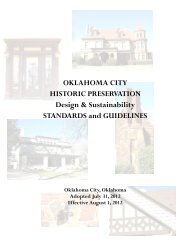OKC Plan, 2000-2020 - City of Oklahoma City
OKC Plan, 2000-2020 - City of Oklahoma City
OKC Plan, 2000-2020 - City of Oklahoma City
Create successful ePaper yourself
Turn your PDF publications into a flip-book with our unique Google optimized e-Paper software.
Most <strong>Oklahoma</strong> <strong>City</strong> residents know the basics <strong>of</strong> our city’s history—a quiet railroad station<br />
on the morning <strong>of</strong> April 22, 1889, a bustling tent city <strong>of</strong> several thousand by nightfall. We know too<br />
<strong>of</strong> our city’s dramatic and successful effort to become the capitol city after statehood in 1907. Many<br />
citizens also know <strong>of</strong> significant properties across the city and the story behind their construction or<br />
demolition. Downtown <strong>Oklahoma</strong> <strong>City</strong> also has many wonderful buildings which are representative<br />
<strong>of</strong> particular historic architectural styles or periods. We have a significant collection <strong>of</strong> historic<br />
commercial structures and landmark buildings, including the Skirvin Hotel, the First National<br />
Building, the Braniff Building, and the Colcord Building. <strong>Oklahoma</strong> <strong>City</strong> has real strengths in<br />
historic preservation in the residential properties found in many <strong>of</strong> our neighborhoods. Thousands <strong>of</strong><br />
homes that were built during the rapid growth <strong>of</strong> the 1910s and 1920s, still stand today. Large and<br />
small well-constructed houses <strong>of</strong> masonry and/or wood line many <strong>of</strong> our city’s streets.<br />
Residential neighborhoods have distinguished themselves as historic districts and are<br />
experiencing their first population growth since the 1950s. Commercial districts such as<br />
Stockyards <strong>City</strong>, Capitol Hill, and Automobile Alley, guided by Main Street Programs, have<br />
benefited from a significant increase in reinvestment due largely to the practices <strong>of</strong> historic<br />
preservation as implemented by local design review bodies. The map on the facing page shows<br />
existing and potential historic districts in <strong>Oklahoma</strong> <strong>City</strong>.<br />
The value <strong>of</strong> historic buildings has been recognized and appreciated during the planning and<br />
construction <strong>of</strong> the Metropolitan Area Projects, several <strong>of</strong> which are based in historic districts or<br />
centered around historic buildings. The cultural community has also demonstrated the value <strong>of</strong><br />
adaptive use by renovating the historic Center Theatre as the centerpiece <strong>of</strong> its new art museum.<br />
And all around the Murrah Memorial, historic structures have been rehabilitated using federal design<br />
guidelines.<br />
Historic preservation is about educating a property owner on the appropriate solutions for<br />
repairing intact historic fabric and altering his/her building to accommodate the modern function.<br />
Historic preservation is used as a tool for the revitalization <strong>of</strong> <strong>Oklahoma</strong> <strong>City</strong>’s older districts.<br />
Additionally, historic preservation is about teaching our children about their heritage. Like most<br />
disciplines, preservation practice has matured. Initially, towns like Williamsburg were frozen in<br />
time or reconstructed for educational purposes to <strong>of</strong>fer a setting in which visitors could imagine<br />
living in another place and time without any visual reference to modern life. The National Historic<br />
Preservation Act <strong>of</strong> 1966, as amended, legislated programs for preserving our heritage and defined a<br />
new direction based on the idea that historic places enrich our quality <strong>of</strong> life and provide a sense <strong>of</strong><br />
stability for communities. The Preservation Act advises us to retain significant historic fabric as a<br />
living part <strong>of</strong> our daily life. Historic preservation allows us to live in a community with visual<br />
reminders <strong>of</strong> our past. It <strong>of</strong>fers us a sense that our values expressed in the built environment are part<br />
<strong>of</strong> a continuum influenced by those who have gone before us and provide the foundation for future<br />
development.<br />
71

















